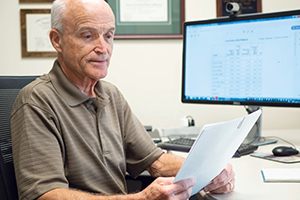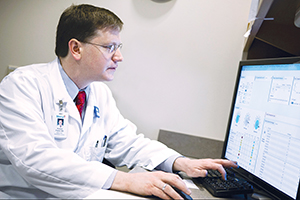By JULIE MINDA
There are numerous medical devices and pharmaceuticals that clinicians affiliated with the Chesterfield, Mo.-based Mercy health system choose from when treating patients. But which products are most effective for patients? And which products return the best clinical outcomes for the cost?
The Real-World Evidence Insights Network that Mercy Technology Services launched in August provides the technology infrastructure needed to track the use of medical devices and drugs for patients throughout the Mercy system and to determine how effective they are for the patients. (Measures being used to track outcomes include infection rates, length of hospital stays, readmission rates, mortality and quality of life.)

Dr. Joseph Drozda, director of outcomes research for Mercy of Chesterfield, Mo., reviews patient data aggregated using Mercy Technology Services' Real-World Evidence Insights Network data platform.
In its formative stages, the database will be a repository for information related to orthopedics, cardiology and oncology. Mercy Technology Services will expand it to include other clinical areas over time. Inpatient and outpatient records from across the continuum of care will be part of the database. Dr. Joseph Drozda, the Mercy system's director of outcomes research, says that database initially will track products such as coronary stents, pacemakers, catheters, artificial knee and hip joint implants and chemotherapy drugs.
Mercy is inviting other health care systems and facilities to join the network and contribute their data on medical product use and efficacy. The intent is to create a pooled database of de-identified quantitative and qualitative patient experience information that providers can analyze to make optimal choices when it comes to the medical devices and pharmaceuticals they'll use with patients.
"This all began as a health care provider wanting to determine which medical products are best, and at the best cost," says Curtis Dudley, Mercy Technology Services vice president of enterprise analytics. "But our data alone is not enough — we need the data from others as well" to make informed determinations.
Information gap
Dudley says there are numerous manufacturer, industry and government reports on the efficacy of products, as well as various analytical reports from private consultants — all intended to help health care providers with product selection. There also is much information available on best practices for treating health conditions, which points to certain products or drugs with best outcomes.

Dudley
However, most such analyses lack significant data on how patients fare with specific products "in the real world," Dudley says.
According to Mercy Technology Services, while the results of clinical trials necessary for U.S. Food and Drug Administration approval of new medical devices are generally published in medical journals, patient-level data necessary to validate outcomes is usually not published after the devices are marketed. In addition, manufacturers do not usually conduct head-to-head comparisons between competing products before or after a new product is brought to market. The real-world data in the Mercy data bank holds the potential to answer the question of how devices compare to one another as they are actually used by clinicians and patients.
Drozda says that much of the data and analysis available to providers up to now amounts to "data dumps." And, Dudley adds that while individual health systems have data in their electronic health record systems on medical devices, pharmaceuticals and patient outcomes, the data often is skewed toward a relatively small number of vendors or products that are in heavy use at each system. As a result, individual health systems can't do head-to-head comparisons on a wide range of competing products.

Dr. Robert Frazier, a physician at Mercy Hospital Washington in Washington, Mo., consults a patient outcomes dashboard developed using Mercy Technology Services' Real-World Evidence Insights Network data platform.
Also, he says, it is extremely difficult to extract, curate and analyze bits of information from medical record systems, in part because of a lack of standardization in the way entries are made. Even differences in how people format a date of service delivery must be dealt with.
Mercy Technology Services' data scientists and clinicians have been developing coding that can translate raw data into a standardized form, to make it comparable across health systems in the consortium and therefore usable, the company said.
Building blocks
Steps that Mercy Technology Services has been taking in the decade-plus since Mercy adopted the Epic electronic medical record system laid the foundation for the Real-World Evidence Insights Network, according to Dudley and Drozda.
For about a decade, Mercy Technology Services has led FDA-funded demonstration projects to barcode coronary stents, and to maintain related clinical records in a database tracking patient outcomes.
The company included in the pilots de-identified patient data from Mercy, Intermountain Healthcare and Geisinger Health system. Drozda has been helping to lead these barcoding studies.
Mercy Technology Services also has undertaken similar industry-funded projects with other devices.
And separately, in recent years, Mercy Technology Services has been working with the SAP technology company to create the platform and related software needed to pull de-identified data on patients using medical devices and pharmaceuticals from the electronic medical records of Mercy and other health systems, orchestrate that data into usable blocs of information and apply analytical tools to make the information useful for decision-making.
Dudley notes that Mercy Technology Services has a team dedicated to finding the best ways to curate raw data so it is useful for analysis, including by using "natural language processing," a type of artificial intelligence that helps computers "understand" and use human language.
'Regulatory-grade' info
Mercy Technology Services says it will welcome health care providers with the capability to supply data to be part of a consortium that both populates and uses the database. Dudley says data providers will be paid for their data. He adds that to protect patient privacy all of the data will be stripped of information that links it to a particular patient before that data exits each provider's firewall and goes into the database's cloud-based information storage.
Drozda says Mercy Technology Services will be pulling in data from more sources over time. For instance, it may incorporate patient input entered through the patient portal, MyMercy, and it may pull in data from insurance companies.
Dudley notes that the platform is set up to process the data in a way that is "regulatory-grade," or of a quality that would be acceptable to the FDA.
Blue sky possibilities
Mercy Technology Services envisions multiple uses for the platform. Mercy plans to provide access to academic researchers, to manufacturers and to regulators overseeing product safety. Those using the platform for commercial purposes will pay subscriber fees to access the database and analytical tools.
Dudley says the database will be useful for monitoring the safety and efficacy of new devices, to flag device defects or problems before the products are used on a mass basis.
Dudley and Drozda say numerous health care providers have expressed interest in joining the consortium, and three global manufacturers have contracted to become subscribers, with others expressing interest as well.